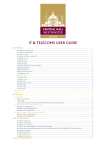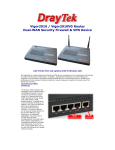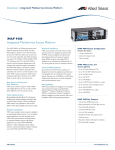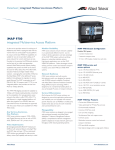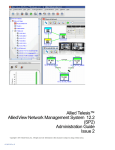Download BT ISDN Installation guide
Transcript
Installation NTE8E Engineer’s Installation Guide British Telecommunications plc 2004 www.bt.com/isdn The ISDN2e Network Terminating Equipment NTE8E is manufactured by Introduction • • • • The NTE8 is the customer termination for the BT ISDN2e service and this document is a guide to the installation procedure. This unit is a direct replacement for the NTE8A, B, C and D. It must not be used as a replacement for an NTE6. This NTE has the addition of a copper by-pass feature that enables a no-customer visit to change service to PSTN or Broadband and will take the place of an NTE5. This unit can also be used on low voltage ISDN lines. Unit Description Enhanced Status LED Network cable entry NTE SW2 L / S ATTENTION! – Default Configuration Check the IN/OUT and L/S switches are both in the default position of “IN” and “S” unless providing Customer Extension Wiring. PSTN Connector Access to removable cover BT Engineer only SW1 IN / OUT ISDN Terminal Equipment 1 Document Number: 8820 1. Wall mounting The NTE8 can be mounted in most domestic and office environments, avoiding direct sunlight, sources of heat, sources of electromagnetic radiation, and areas which are subject to high humidity such as kitchens and laundry rooms etc. The NTE must be mounted with the customer sockets facing down. Use the template provided with this guide to mark the two fixing screw positions. Please note that a minimum of 190mm clearance is required (marked by dashed lines) to enable the customer to insert and remove the extension cabling or terminal equipment plugs into the RJ45 sockets and to enable the installation engineer to open and remove the cover. CAUTION: Before drilling holes, make sure that there are no concealed installations (e.g. power, water, gas). Drill (∅ 6 mm) and plug the wall for the two crosshead screws provided. For a hollow wall, suitable proprietary fixing should be used. If fitting to wood, drill suitable pilot holes. Position the screw that will mate with the keyhole fixing, leaving approx 2mm protruding (see fig. 2a) to allow a snug fit in the slot and the NTE lies flat against the mounting surface without any case distortion. Hang the NTE over the screw head and pull it Figure 2a down until it locks in place safely (see fig. 2b). Then insert the second screw in the lower hole. Ensure that the case fixings are sound and that there is no movement, but do not over-tighten the securing screws. Figure 2b Figure 1 2 11. October 2004 ATTENTION! Dangerous Voltage! The ISDN connection is a voltage source that should be inaccessible to the user. The NTE cover shall only be opened by BT ISDN trained engineers. Do not touch the PCB unless you are wearing an anti-static strap. The strap is not required for normal line installation. Do not install the NTE or work on the line during thunderstorms. 3. Lightning Protection Lightning protection shall be provided as for standard PSTN lines. Where the service is provided via aerial cable either over more than three spans, or in areas with a high risk of electric storms, the circuit may require additional protection. Please refer to the Lightning Protection Handbook ISIS/EPT/PPS/B055. 2. Connecting the NTE8 to the Network Remove the BT Engineer-only-removable cover to gain access to the network wiring connectors. This cover is attached to the lower part of the NTE with a clip. To loosen the locking mechanism use a No.1 screwdriver and push it slightly into the rectangular slot above the switch marked “OUT” (see Unit Description). Strip approximately 100mm of sheath from the network cable, feed the cable into the NTE and route the cable through the chicane. (see fig. 3). Terminate the cable on the IDC, wiring polarity is unimportant. Replace the network access cover. 4. Customer S-Bus Extension Wiring (Chargeable Option) Cable to category 5 specification should be used to complete the installation. Please refer to the table below for RJ45 wiring and Figure 5 for sample wiring configurations / switch settings. All extension wiring MUST have a Type 2 socket (which incorporates terminating resistors), as the last socket. Further wiring details can be found in BS EN 50098-1. SW3 for Bypass function (see chapter 6), default setting: Plug & Play Network cable IDC connector ISDN Plug&Play Network cable Tension relief Figure 3 Write the customer directory and fault reporting number on the customer service label. Pin 1 2 3 4 5 6 7 8 Wire colour White/orange Orange/white White/green Blue/white White/blue Green/white White/brown Brown/white TE P Source 3 P Source 3 Transmit Receive Receive Transmit P Sink 2 P Sink 2 NT P Sink 3 P Sink 3 Receive Transmit Transmit Receive P Source 2 P Source 2 5. Testing and fault locating A green LED in the centre indicates the status of the NTE. OFF ON (dim) Flashing quickly (8 Hz) Flashing slowly (1 Hz) ON (bright) LED Indicator No Service or device in bypass mode Exchange line Voltage > 30V but line side deactivated, no layer 1 Network connection activating Normal Service (layer 1) with No Customer Terminal Equipment (CPE) connected or detected. Network connection active but customer side S-Bus deactivated (or activating). Normal Service (layer 1) with CPE connected and detected. 3 4 Hinweis für die Herstellung: Papier unterhalb dieser Linie abschneiden! Note: Cut off paper below this line! If the LED is ON (bright) then voice and data testing should be completed by using an ISDN Basic Access Tester, Digital CPE Simulator, laptop or similar device. Use the tester to confirm “Power Source 1 restricted”. A brightly lit state will confirm layer 1 activated but not the presence of a TEI. On System X exchanges a double slow flash may be observed every 15 seconds, this is caused by the line card toggling between Info State 2 and 0. This is typical of all embedded System X lines when there is no CPE connected or CPE is detected but not in the correct Info State. The LED not lit or permanently fast flashing indicates a problem with the network connection. A permanently slowly flashing LED could indicate a problem with the customer wiring or CPE. BT Engineers Assistance Website - http://customerservice.intra.bt.com/eassistant/ 6. NTE Bypass function for PSTN and Broadband mode (Extended Use) The NTE will detect the line voltage from the exchange and switch automatically to the ISDN or PSTN mode. The NTE will provide PSTN service to the PSTN socket if a standard analogue line card is used and will act as an NTE5. When the ISDN service is jumpered/enabled in the Local Exchange, the NTE supports ISDN services and the PSTN socket is disconnected. The NTE will switch back to the analogue PSTN mode if the ISDN service is removed/de-configured. The NTE will switch out of copper bypass at 75 ±8 volts and switch back into copper by-pass when the voltage falls below 30 ±3 volts. An internal switch SW3 (position: see fig. 3) is provided so the installer can over ride the by-pass feature to allow operation on low voltage ISDN lines. 7. Example S-BUS Connections Short passive bus 150m max. S/T NTE 8 < 1m max. TE1 TE2 TE8 Switch IN/OUT to OUT and L/S to S Last socket (TE1) must include termination resistors Daisychained 150m max. S/T TE1 NTE 8 TE2 TE8 Switch IN/OUT to OUT and L/S to S Last socket (TE1) must include termination resistors Extended Passive Bus 500 m ... 800 m 25 m ... 50 m S/T NTE 8 <1m TE 1 TE 2 TE 4 Switch IN/OUT to OUT and L/S to L Last socket (TE1) must include termination resistors Point-to-Point 150 m ... 800 m Network cable entry S/T NTE 8 Analogue & ADSL Equipment TE1 Switch IN/OUT to OUT and L/S to L Socket (TE1) must include termination resistors Figure 5 Figure 4 5 6 Functional Block Diagram Safety By-Pass Detection This equipment complies with the European directives 89/336/EEC “Electromagnetic Compatibility” (EMC) and 73/23/EEC “Low Voltage Directive”. Do not work on the NTE and its wiring, e.g. connect or disconnect cables, during periods of lightning activity. RJ45 RJ45 Exch ISDN- signal switching unit 1µ8 2µ2 PSTN 470k 470k PSTN / ADSL Broadband By-Pass Figure 6 Technical Data U interface TS 102 080, Annex A Channel structure 2B+D, synchronization and service data Line code 2B1Q Net data rate 144 kbps (2 x 64 kbps + 16 kbps) Safety status TNV3 (Telecommunication Network Voltage) S/T interface according to ETS 300 012 Channel structure 2B+D, synchronization and monitoring Bus configuration: S = Short passive bus (default setting) IN = 50Ω Terminating Resistors Safety status TNV1 (Telecommunication Network Voltage) Power ITU-T I.430 Wattage on S/T interface < 420 mW in operation Dimensions and environmental conditions Storage ETS 300 019-1-1, Class 1.1 (-25°C to +55°C) Transport ETS 300 019-1-2, Class 2.3 (-25°C to +55°C) Operation ETS 300 019-1-3, Class 3.2 (-5°C to +55°C) Case 123 x 130 x 50 mm Weight 0.5 kg Our products are subject to continuous further development and improvement. 7 Hazardous Voltages ! Remote Power Feeding / ISDN connection (Line) The ISDN connection is regarded as a source of voltage that should be inaccessible to user contact. Do not attempt to tamper with or open the NT1 or the connection hardware. Maintenance must be made only by suitably trained engineers. ESD Protection (for service personnel) When handling the unit with the cover opened, please use ESD protection methods acc. to EN 100 015. Not required for normal installation. All customer ordered facilities must be tested prior to handover to customer. This guide should be retained for future reference. Returns If the NTE is proved to be faulty on installation, please return it using the BT return procedure. If you have any comments to make about this documentation, or the ISDN NTE please email: [email protected]. The information contained in this guide is correct at the time of going to press, but it is not comprehensive and shall not form any part of a contract. Some products and services may not be available in all areas. Whilst we do our best to supply customers with the products and services that they ask for, we reserve the right to supply products and services which do not accord exactly with the descriptions and illustrations in this guide. Hinweis für die Herstellung: Papier unterhalb dieser Linie abschneiden! Note: Cut off paper below this line! 8


